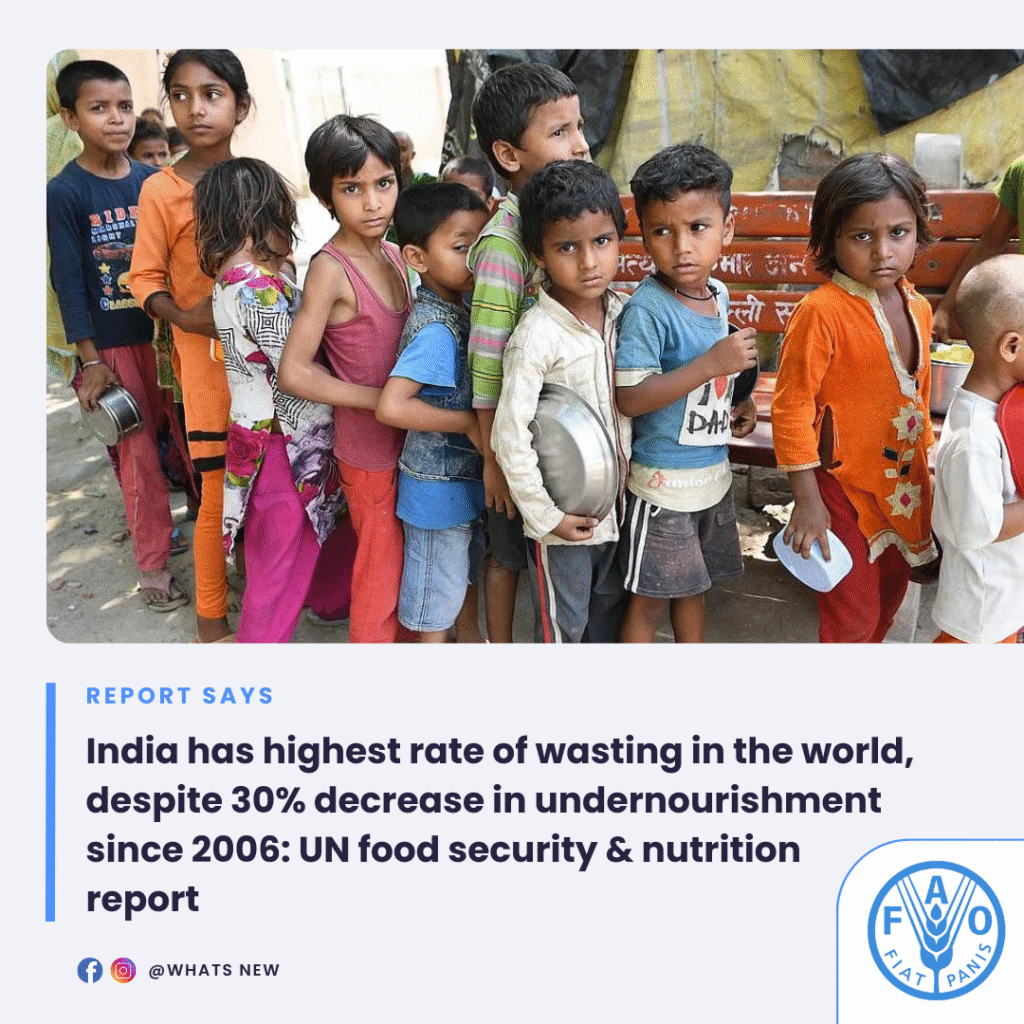Healthy eating a luxury for nearly half of India’s population due to high food prices
As much as 18.7 percent of Indian children under the age of five suffered from wasting in 2024, the highest rate in the world, India stand in SOFI 2025 Report. According to the United Nations’ 2025 State of Food Security and Nutrition in the World (SOFI) report released on July 28.

- India leads globally with 18.7 percent of children under five wasted in 2024, over 21 million affected.
- About 37 million children under five in India are stunted, indicating chronic undernutrition problems.
- Over half of Indian women aged 15-49 suffer from anemia, reaching 53.7 percent in 2023, 203 million total.
- Despite gains, 12 percent of Indians were undernourished in 2024; 42.9 percent cannot afford healthy diets.
India stand in SOFI report says: undernourishment, Improvement, but Still Massive
The estimates about India stand in SOFI report that around 172 million Indians (about 12% of the population) were chronically undernourished in 2024—down from roughly 243 million in 2006, but still among the highest numbers globally. India remains the country with the largest absolute number of undernourished people. Nearly 43 % of the population cannot even afford a healthy diet—an alarming 42.9 % in PPP terms, up from USD 2.77 in 2017 to USD 4.07 in 2024.
Despite record harvests and expansion of subsidized grain programs, hunger persists—evidence of the continuing gaps in India’s food security architecture.
Child Malnutrition: A National Emergency
India has the world’s highest child wasting rate, at 18.7 %, affecting over 21 million children under five. Meanwhile, 37.4 million under-five children are stunted—35.5% prevalence—far above the South Asian average of 21.8%. This double burden—chronic undernutrition and acute weight loss—reflects severe systemic failures.
Anaemia: A Silent Crisis Among Women
More than 53.7% of women aged 15–49—about 203 million—are anemic, placing India fourth globally behind countries like Gabon and Mali. Maternal and micronutrient nutrition remains deeply neglected.
Overweight & Obesity: The Other Side of Malnutrition
Despite widespread undernutrition, India faces a rise in overweight and obesity. Overweight children under five climbed from 2.7 million in 2012 to 4.2 million in 2024, and adult obesity now affects 71 million people—a pronounced coexistence of both under- and over-nutrition.
Government Mismanagement and Failures: Why the Crisis Persists
Public Program Weaknesses and Budget Missteps
- The Public Distribution System (PDS)—meant to feed the poorest—is riddled with inefficiencies. Despite being under the National Food Security Act (NFSA), only about 59% of people were covered by NFSA cards by 2020; overall PDS reached 67%, leaving over 100 million people excluded, largely due to outdated census-based targeting and frozen rolls.
- Nutrition programs like ICDS and Mid‑Day Meals (PM‑POSHAN) suffer from chronic underfunding and operational lapses. Budget allocation for ICDS and MDM has declined in real terms—over the past decade, by as much as 40%, while the 2025 budget barely increased by 0.26%, not keeping up with inflation.
- Anganwadi centers often lack trained staff, hygiene facilities, and the quality of take-home rations suffers; urban migrants and the informal poor are largely excluded from these schemes.
Ideology and Protein Denial
Several BJP-ruled states have imposed bans on eggs in school meals, pushing vegetarianism in the name of ideology. Yet eggs are one of the cheapest, nutrient-dense protein sources. Critics argue this policy further aggravates protein deficiency among children from marginalized groups.
Productivity Gaps and Climate Stress
Though India is a top grain producer, farm productivity per hectare lags far behind global peers like France or China, holding total factor productivity growth at below 2% per year. Climate events—including record heatwaves and droughts—have damaged yields, disrupted supply chains, and driven inflation in food prices. Crop losses due to poor water management and infrastructure continue to hit nutritional outcomes.
Malnutrition Overlooked: Focus on Calories, Not Diet Quality
Government interventions heavily focus on caloric sufficiency—mainly grains—while sidelining protein, micronutrients, and dietary diversity. Over-reliance on PDS grains fails to address hidden hunger of vitamins, minerals, and balanced meals.
Cultural preferences, misinformation, and lack of public nutrition education further limit demand for diverse, nutritious diets.
Toward a Better Future: Where India Must Improve
To reverse these troubling trends, India must:
- Expand and modernize NFSA coverage, updating eligibility beyond 2011 census data to ensure inclusion of all vulnerable households.
- Deeply reform ICDS and school meal systems, boosting budgets, improving service quality, and including diverse protein sources like eggs and legumes.
- Invest in agricultural productivity and infrastructure, ensuring efficient storage, transport, and climate resilience and reducing food waste.
- Shift policy focus from calories to nutrition, promoting balanced dietary access and public awareness campaigns around balanced nutrition.
- Address urban food deserts and ensure migrant workers’ access to nutritious, affordable food.
The Human Cost
India stand in SOFI report underscores a cruel reality: millions of Indians remain hungry, malnourished, and anemic—and yet the government’s response is inadequate. Hunger might be slowly falling, but for millions of children and women, progress is painfully slow. India’s leadership needs to confront the failures head-on: exclusion in social safety nets, ideological rigidity over protein sources, underfunded welfare schemes, and neglect of diet quality. Without urgent and compassionate reform, the promises of a hunger-free India will remain unfulfilled.
